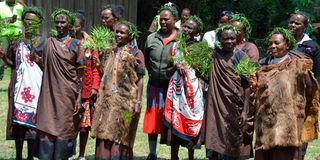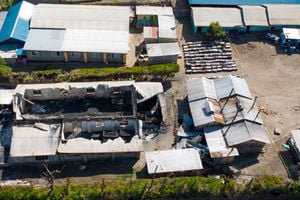Ogieks intensify efforts to restore depleted Mau Forest

Ogieks entertain guests during the renewal of Participatory Forest Management Plans for 2023-2027.
What you need to know:
- Mau Forest lost 19 per cent of its tree cover, amounting to 533 square kilometers between 2001 and 2022, according to satellite data from the monitoring platform Global Forest Watch.
- Communities in the region have initiated a programme dubbed ‘Linda Maji Initiative’ to save the forest.
Wetlands are also valuable for flood protection, water quality improvement, shoreline erosion control, natural products, recreation and aesthetics.
The consortium, which has 2,000 members, has so far planted 16,000 tree seedlings on the 39 acres of Oleinguse wetlands. The Ogieks are living as squatters after they were evicted from Mau Forest.
In 2022, the African Court on Human and Peoples' Rights in Arusha ordered the community to be compensated Sh58 million for the material prejudice they suffered and Sh100 million for violations of their basic human rights.
Eldoret -Iten Water and Sanitation Managing Director Peter Biwott said degradation of Mau will intensify climate change and food insecurity.
Mr Biwott said the degradation of Mau Forest has threatened biodiversity and water security for 500,000 residents of Eldoret town and over 30 million people who depend on Lake Victoria.
Mau Forest lost 19 per cent of its tree cover, amounting to 533 square kilometers between 2001 and 2022, according to satellite data from the monitoring platform Global Forest Watch.
Communities in the region have initiated a programme dubbed ‘Linda Maji Initiative’ to save the forest.
Cheptogei Forest Station Manager Laban Gitiba said the rapid degeneration of water towers in Southwest Kenya calls for the involvement of the local communities.
Mau Forest has a rich biodiversity including the endangered African bush elephant (Loxodonta Africana) and the African golden cat (Caracal aurata).
It is also home to an antelope known as the yellow-backed duiker (Cephalophus silviculture), the side-striped jackal (Lupulella adusta), and the nocturnal bongo antelope (Trgelaphus eurycerus).
The region is classified as an Important Bird Area by Birdlife International due to its rich and diverse bird communities.
The forest hosts very rare animal species and unique endemic plants such as orchids.
The Nature Conservancy Resilient Watershed Manager Peter Kibet said the conservancy will spend Sh9.6 billion in conservation efforts.
Elgeiyo Marakwet County Water, Environment and Climate Change Executive Jason Lagat said the devolved unit was working with other partners in the conservation agenda to reduce the poverty index of the county, which stands at 43 per cent. The county is focused on planting 200,000 fruit trees like avocados in the next three years.
The initiatives are geared towards achieving SDG 6, which seeks to ensure safe drinking water and sanitation for all and sustainable management of water resources.
Studies indicate that indigenous people safeguard and nurture 80 per cent of the world’s cultural and biological diversity while only occupying 20 per cent of the lands globally. They possess indigenous knowledge and vital solutions key to ecosystem restoration and carbon sinks.
During the COP28 in Dubai, the 300 indigenous communities were largely ignored in key decision-making processes including clean energy transition and carbon markets.





